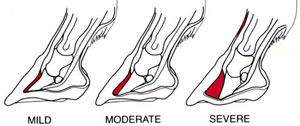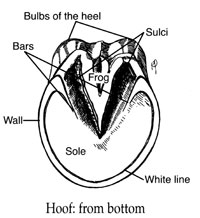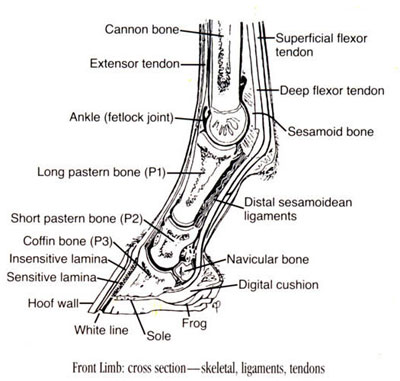Laminitis
Laminitis results from the disruption of blood flow to the sensitive and insensitive laminae.
These laminae structures within the foot severe the coffin bone (wedge shaped bone within the foot) to the hoof wall.
Inflammation often permanently weakens the laminae and interferes with the wall/bone bond.
In severe cases the bone and hoof wall can separate. In these situations, the coffin bone may rotate within the foot, be displaced downward, sink and eventually penetrate the sole. This disease can affect one or all feet but is most often seen the front feet concurrently.
Terms laminitis and founder are used interchangeably. However founder usually refers to the chronic (long term) condition associated with rotation of the coffin bone. An acute case is when you have symptoms associated with a sudden initial attract including pain and inflammation of the laminae.

Causes
Although this ailment occurs in the feet. The underlying cause is often a disturbance elsewhere in the horses body, the cause vary and may include the following:
Digestive upsets due to grain overload (excessive grain, fruits or snacks)
An abrupt changes in diet
Sudden access to excessive amounts of lush forage before the horses system has had time to adapt. (known as grass founder
Toxins released within the horses system
High fever or illness, any illness that causes high fever or serous metabolic disturbances has the potential to cause laminitis (Potomac horse fever is one
Severe colic
Retained placenta in the mare after foaling
Consumption of cold water by an overheated horse
Excessive concussion to the feet, (road founder)
Excessive weight-bearing on one leg due to injury of another leg, or any other alteration of the normal gait
Various primary foot diseases
Bedding that contains black walnut shavings
Prolonged use of high does of corticosteroids
Risk factors
Factors that seem to increase a horses susceptibility to this disease or increase severity of the condition when it does occur included the following:
Heavy breeds such as draft horses
Overweight body
High nutritional plane feeding large amounts of carbohydrate-rich meals
Ponies, Morgans and donkeys
Unrestricted grain binges, breaking into the feed room (if this happens, do not wait for symptoms to develop, call immediately so corrective action can be taken before tissue damage progresses
Horses who had previous episodes
Older horses are more susceptible to Laminitis due to Cushings Disease
Signs
Lameness especially when a horse is turning in circles, shifting lameness when standing
Heat in the feet
Increased digital pulse in the feet
Pain in the toe region when pressure is applied with hoof testers
Reluctant or hesitant gait. walking on eggshells
A sawhorses stance with the front feet stretched out in front to alleviate pressure on the toes and the hind feet camped out or positioned farther back than normal or bear more weight.

Signs of a chronic case may include the following:
Rings in hoof wall that become wider as they are followed from toe to heel
Bruised soles or stone bruises
Widened white line, commonly called seedy toe with occurrences of seromas (blood pockets) and or abscesses
Dropped soles or flat feet
Thick cresty neck
Dished hooves, which are the result of unequal rates of hoof growth (the heels grow at a faster rate than the rest of the hoof, resulting in an Aladdin-slipper appearance)
Treatment - The sooner treatment begins, the better the chance for recovery.
Diagnosing and treating the primary problem: laminitis is often due to a systemic or general problem elsewhere in the horses body
Dietary restrictions: stop feeding all grain based feeds and pasture, feed only grass hay until advised otherwise by your veterinarian.
Treating with mineral oil, via a nasogastric tube: to purge the horses digestive tract, especially if the horse has overeaten
Administering fluids if the horse is ill or dehydrated
Drugs such as antibiotics to fight infection, anti-endotoxins to reduce bacterial toxicity, anticoagulants and vasodilators to reduce blood flow to the feet
Stabling the horse on soft ground sand or shavings encouraging the horse to lie down to reduce pressure on the weakened laminae
Opening and draining any abscesses which may develop
Cooperation between you veterinarian and the Ferrier (techniques of corrective trimming, frog supports, and therapeutic shoes or pads.)
Managing of laminitis
If a horse has had laminitis it may be likely to recur. Extra care is recommended for any horse that has had laminitis
A modified diet that provides adequate nutrition based on high-quality forage, digestive fiber (beet pulp) and oil, avoiding excess energy, especially from grain
Routine hoof care, regular trimming and therapeutic shoeing
A good health maintenance schedule, including parasite control and vaccinations to reduce horses susceptibility to illness or disease.
Feeding of a nutritional supplement formulated to promote hoof health
Avoid grazing lush pastures, especially between late morning and late afternoon hours, since plant sugars are the highest during these times
Restrict pasture intake during spring or anytime the pasture suddenly greens up
Keep all grains stored securely out o the reach of horses
Introduce you horse to lush pasture gradually
Formulate a good dietary plan with the help of your veterinarian
Provide good routine health and hoof care.
If you suspect laminitis, consider it a medical emergency and notify your vet immediately.
Many horses that develop laminitis make uneventful recoveries and go on to lead long and productive lives.
Unfortunately, others suffer such severe, irreparable damage that they are, for humane reasons, euthanized.

Move From Laminitis Back To Equine Health.
Move Back To Living With Horses Home Page
Products
|
|
|

